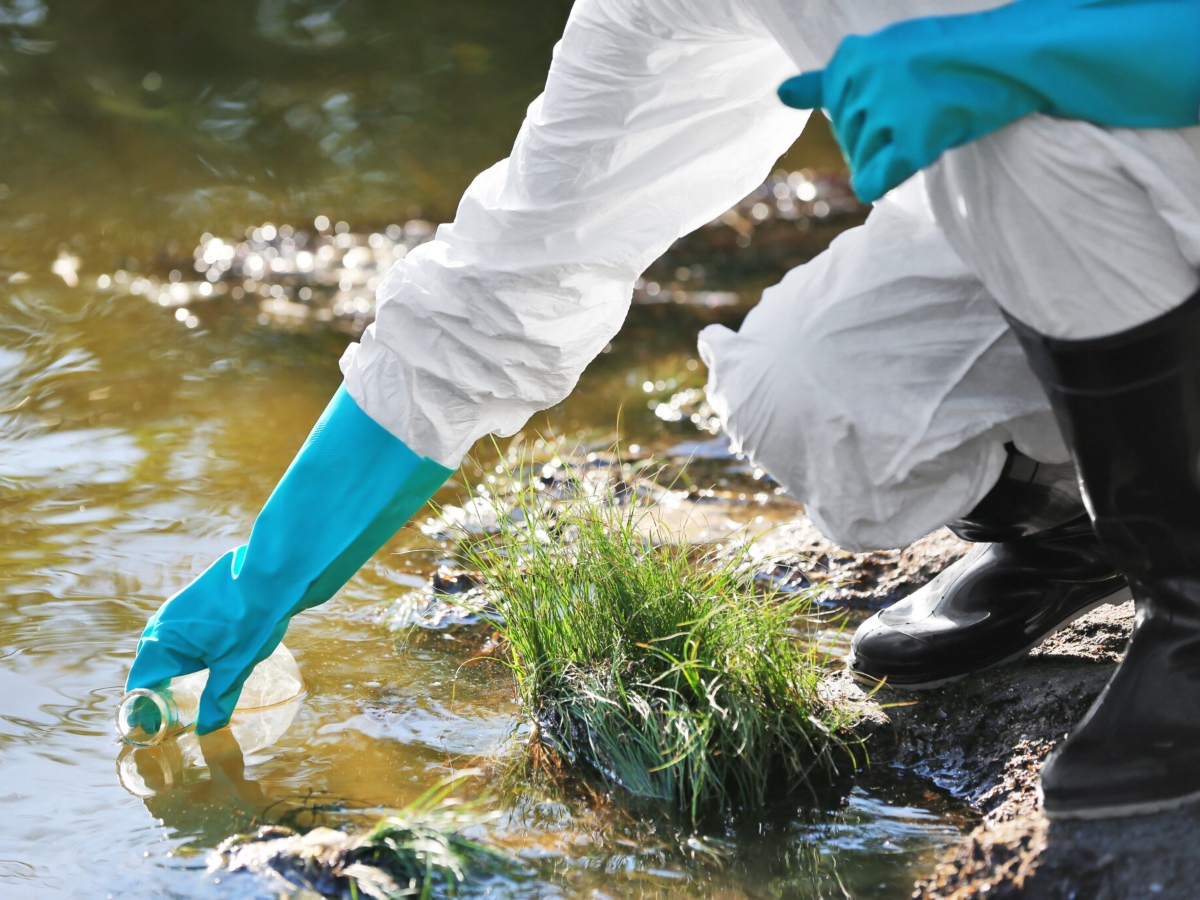Perfluorobutane sulfonate (PFBS) is a type of per and poly-fluoroalkyl substance (PFAS) most popular in many industries, including aviation, automotive, electronics, firefighting, food processing, and waterproof clothing. The high usage of PFAS in various consumer products has led to its prevalence in the air, soil, and water. This creates a major concern, as PFAS chemicals are known to be toxic.
So, what is PBFS? Where can you find them, and are they harmful to humans? If you’re asking yourself these questions, this article is for you. We will explore what PBFS are, their source of exposure, and whether they pose any health risks.
What Is PFBS?
Perfluorobutane sulfonate, commonly referred to as PFBS, is a chemical compound used as a surfactant or wetting agent in many industrial processes. PFBS is one of the many chemicals that belong to the PFAS class. PFAS are a group of man-made chemicals used in various industrial and consumer products.PFBS is best known for its chemical stability and heat resistance, making it a useful additive in different applications. This chemical is stable and nonreactive and comes in a colorless liquid or a corrosive solid form. PFBS is persistent, making it hard to break once released into the environment.
PFBS is a short-chain PFAS due to its relatively shorter carbon chain than its long-chain counterparts. Short-chain PFAS has four perfluorinated carbon atoms in its backbone and is less persistent, bioaccumulative, and toxic in the environment than long-chain PFAS. It also clears in the human body faster than perfluorooctane sulfonate (PFOS) and perfluorooctanoic acid (PFOA), the most common PFAS. Many manufacturers, like 3M, prefer PFBS to perfluorooctanesulfonic acid (PFOS). PFOS has eight carbon atoms, making it more harmful to plants, wildlife, and humans.
The Environmental Protection Agency (EPA) states that PFBS is highly mobile and very soluble in water.
Where Are PFBS Found?
PFBS is present in the soil as it can adsorb organic matter and persist for a considerable time. The chemical has also been detected in water sources, including groundwater and surface water. PFBS is easily transported over longer distances, leading to contamination of well water and lakes and rivers where drinking water comes from.
In addition, PFBS can be found in the air, fish, and other animals. Besides, PFBS being in the environment is also present in consumer products. These products include:
- Some food packaging materials, such as pizza boxes
- Personal care products like cosmetics, creams, perfumes, ad detergents
- Fire fighting fam
- Non-stick cookware such as Teflon
- Stain resistant carpets
- Waterproof clothing such as rain jackets
It’s good to note that the most studied PFAS are PFOA and PFOS, meaning much information is gathered through studies and research. On the other hand, PFBS needs more research and monitoring to assess and focus on transport and the potential impacts on human and environmental health.

How Does PFBS Get into the Environment?
PFBS can be released into the environment in various ways, including:
- Industrial discharges: Industries that use or manufacture products containing PFBS may release it into water bodies through wastewater discharges. This discharge leads to water contamination that plants, animals, and humans depend on.
- Landfill leachate: PFBS can leach into the surrounding soil and groundwater when people dispose of products containing the chemical in landfills. As a result, the chemicals can reach your well water or, through runoff, reach surface water and end up in your tap water.
- Atmospheric deposition: Industrial emissions or volatilization can release PFBS into the air. Due to the chemical’s high mobility, it can move over long distances through the air and get deposited onto land and water surfaces.
- Firefighters foam: Firefighters use Aqueous film-forming foam (AF) to fight difficult-to-suppress fires, releasing PFBS into the environment. This chemical can leach into the soil, reach groundwater, or be washed into surface water sources.
Are PFBS Chemicals Harmful to Human Health?
As mentioned earlier, few studies have been conducted on PFBS to understand its environmental effects and impact on human health. However, numerous studies on other PFAS, especially PFOA, and PFOS, have raised concerns about potential health risks.
According to some research, some PFAS compounds may lead to adverse health effects, including:
- Developmental issues
- Liver and kidney damage
- Thyroid disease
- Reproductive effects
- Increased chances of pregnancy-induced hypertension (preeclampsia)
- Some cancers, such as testicular and kidney cancer
It’s worth noting that these effects are based on studies on various PFAS as a group and not specific risks of PFBS. Since PFAS compounds have different characteristics, they may cause different effects. According to the EPA, studies on animals have shown effects on reproductive organs, which may cause thyroid, fetus, liver, and kidney after oral exposure. Some sources suggest PFBS can cause adverse effects on human health, but the bottom line is that studies on the effects of PFBS are minimal.
How Are People Exposed to PFBS?
You can be exposed to PFBS in various ways, including
- Drinking contaminated water
- Eating contaminated food such as fish
- Consumer products, especially if they are not adequately bound
- Inhaling PFBS-polluted air
- Occupational exposure through inhalation, skin contact, or accidental ingestion.
PFBS and Drinking Water
PFBS is present in some public water systems and private drinking water wells, especially in areas where industrial processes use the compound. This raises a significant concern due to its ability to build up in the human body over time and its potential health effects. EPA’s new rule seeks to regulate six PFAS, including PFBS, PFAS, and PFOS. According to the EPA’s action plan, the Health-Based Water Concentration (HBWC) for PFBS is 2,000 parts per trillion (ppt).
If you rely on water from a public water system, don’t be comfortable and think the water is PFBS-free. According to a study by the U.S. Geological Survey (USGS), which tested 32 individual PFAS compounds, PFBS was among the most compounds present in the water. Testing your drinking water regularly to check PFBS levels is essential, especially if you live near industries that use these chemicals. The EPA is responsible for regulating PFBS in public drinking water systems. However, it’s important for well owners to know they’re solely responsible for the quality of their well water.

How Can You Reduce Your Exposure to PFBS?
Even though you may sometimes be exposed to PFBS without knowing it, you can avoid excess exposure to this harmful chemical in a few ways. Here are a few tips:
- Review product labels carefully to ensure they do not contain PFBS or any other PFAS.
- Limit the use of stain-resistant and non-stick products
- Invest in a water filtration system
- Check local advisories and guidelines regarding fish consumption
- Ventilate your home, particularly if you use PFBS products.
- Follow workplace safety guidelines if you work in an occupation that requires you to handle PFBS.
- Test your drinking water regularly, even if you have a water filter
- Avoid watering your plants with PFBS-contaminated water
- Stay updated on your local regulations and guidelines on PFBS or other PFAS
- Take part in the federal regulatory process
Which Water Filtration Method Is Effective at Removing PFBS?
The most effective treatment options for removing PFBS from drinking water are reverse osmosis (RO) and granular activated carbon (GAC).
- Reverse osmosis: RO systems remove contaminants from your water, including PFBS and other PFAS, by pushing water through a semipermeable membrane. The membrane allows only clean water to pass, leaving impurities on the other side.
- Granulated activated carbon (GAC): GAC adsorbs and traps PFBS molecules onto its surface. It can adsorb taste and odor compounds, natural organic matter, synthetic organic compounds, and volatile organic compounds (VOCs).
Where to Find More Information About PFBS and PFAS
Since the EPA is the primary agency that regulates Forever Chemicals, it’s easier to get more information regarding PFBS and PFAS from them. EPA also lists the following federal and state government resources:
- U.S. Environmental Protection Agency (EPA)
- Agency for Toxic Substances and Disease Registry (ATSDR)
- National Institutes of Health (NIH)
- Food and Drug Administration (FDA)
- United States Department of Defense (DOD)
- United States Navy
- United States Air Force, Civil Engineering Center
- Association of State Drinking Water Administrators (ASDWA)
- Interstate Technology and Regulatory Council (ITRC)
- Environmental Council of the States (ECOS)
- Environmental Research Institute of the States (ERIS)
Get PFAS Free Drinking Water with ONIT Home
PFBS is a type of PFAS commonly known for its chemical stability and heat resistance in industrial processes. While PFBS is a safer alternative to PFOS, it has its downsides for the environment, animals, and humans. Due to its widespread use, PFBS has become a common contaminant in water sources, and it eventually reaches our homes through tap water or well water. Consuming PFBS-contaminated water may harm you and your family’s health, hence the need for a water filtration system.
At ONIT Home, we help determine your water’s quality and help you design a system that will meet your needs. We have different systems that can eliminate numerous pollutants from your water, whether it’s PFAS, microorganisms, heavy metals, or VOCs, to mention a few. Our reverse osmosis and whole-home water filtration systems can effectively remove PFBS and other PFAS from your water, leaving you with clean, better-tasting drinking water. Call us now at 1-833-433-0331 to speak to our professionals. Need PFBS-free water? We’re ONIT!



